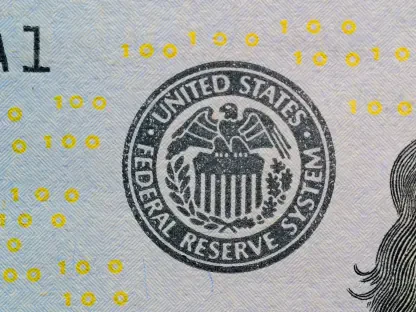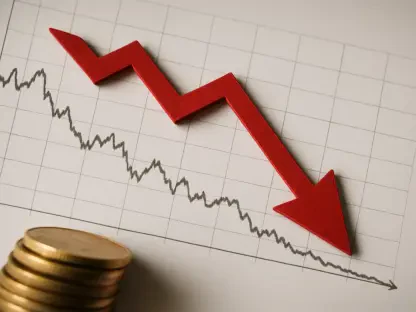Setting the Stage: Monetary Policy at a Critical Juncture
Amid a backdrop of economic resilience and lingering uncertainties, the Federal Reserve’s looming decision on interest rate cuts has ignited fervent discussions across financial markets. With an 85-87% probability of a rate reduction already factored into market expectations for the near term, driven by recent underwhelming economic indicators like the latest jobs data, a pressing concern emerges: could this policy shift propel stock valuations into dangerous territory? This analysis aims to dissect the potential ramifications of such monetary easing on the U.S. stock market, particularly the S&P 500, exploring whether it might spark a new bubble reminiscent of past speculative frenzies.
The significance of this topic cannot be overstated, as the interplay between central bank actions and equity markets often dictates investor sentiment and economic stability. Historical patterns suggest that lower borrowing costs can fuel asset price surges, sometimes detached from fundamental value, leading to sharp corrections. By examining current trends, historical lessons, and expert projections, this piece seeks to provide clarity on whether the anticipated rate cuts could be a double-edged sword for investors navigating an already buoyant market.
Deep Dive into Market Trends and Projections
Historical Echoes: Lessons from Past Rate-Driven Bubbles
Examining history offers critical insights into the potential consequences of monetary easing. The late 1990s dot-com bubble stands as a cautionary tale, where low interest rates facilitated a speculative rush into tech stocks, inflating valuations to unsustainable heights before a dramatic collapse. Similarly, the lead-up to the 2008 financial crisis saw reduced rates encouraging excessive leverage in housing markets, amplifying systemic risks. These episodes highlight a consistent theme: cheap capital often drives investors toward riskier assets, occasionally blinding them to underlying economic realities.
This historical context is particularly relevant today as markets stand at a crossroads. While the economic environment differs from past bubbles—with stronger regulatory frameworks and more seasoned investor behavior—the temptation to overextend in a low-rate setting persists. Understanding these past dynamics underscores the need for vigilance, as the Federal Reserve’s potential moves could either stabilize growth or sow seeds of speculative excess in equity markets.
Current Market Pulse: Strength Masking Vulnerability
Turning to the present, the U.S. stock market, as gauged by the S&P 500, exhibits remarkable vigor. Economic growth has surpassed expectations, bolstered by robust private sector debt activity and a notable rebound in corporate earnings from prior lows. Since hitting a recent trough earlier this year, the S&P 500 has climbed an impressive 28%, undeterred by external pressures such as tariff-related uncertainties. This momentum paints a picture of a market ripe for further gains, particularly if borrowing costs decline.
However, beneath this bullish facade lies a latent risk of overvaluation. The very factors driving market strength—optimism around growth and corporate performance—could morph into complacency if cheaper capital from rate cuts amplifies speculative behavior. Analysts have noted that while fundamentals remain supportive, the rapid ascent of stock indices raises questions about sustainability, especially in sectors heavily reliant on growth projections rather than current profitability.
Rate Cuts on the Horizon: Booster or Bubble Inflator?
The anticipated Federal Reserve rate cuts add a layer of complexity to this already dynamic landscape. A gradual easing of rates could reinforce positive economic trends, providing a soft landing for markets while sustaining corporate investment and consumer spending. Projections suggest a base case scenario where the S&P 500 might reach 6,900 within the next 12 months, reflecting a moderate 9% increase from current levels, underpinned by steady policy support.
Yet, there’s a darker possibility on the horizon. Aggressive rate reductions, particularly if the terminal rate drops sharply, could propel valuations into dangerous territory. A specific threshold to monitor is an S&P 500 level of 7,500—a 19% surge from today’s figures—which some strategists flag as indicative of speculative mania akin to the dot-com peak. Such a scenario would likely stem from excessive risk-taking, as low borrowing costs entice investors to chase returns in overvalued assets, potentially setting the stage for a painful correction.
Wall Street’s Divided Outlook: Optimism Tinged with Caution
Broader sentiment among market participants mirrors this duality of opportunity and risk. The S&P 500’s record-setting rally has fueled debates over whether current valuations are justified by economic fundamentals or inflated by exuberance. On one hand, improving earnings and macroeconomic resilience provide a solid foundation for continued growth, with some analysts arguing that the market has room to run even without aggressive policy stimulus.
On the other hand, cautionary voices point to the fragility of this rally. External shocks, such as geopolitical tensions or unexpected economic slowdowns, could exacerbate vulnerabilities if valuations are stretched. The consensus seems to hover around a delicate balance: while rate cuts might catalyze short-term gains, they also heighten the risk of a bubble if investor enthusiasm outpaces rational assessments of value. This polarized perspective emphasizes the importance of monitoring both policy signals and market reactions closely.
Emerging Trends and Future Risks: A Volatile Path Ahead
Looking toward the immediate future, several trends could shape the trajectory of U.S. equities under a rate-cut regime. The growing reliance on technology and artificial intelligence as investment themes may drive disproportionate gains in specific sectors, further inflating valuations if capital becomes even cheaper. Additionally, any signs of an economic slowdown could prompt the Federal Reserve to adopt a more dovish stance, potentially accelerating bubble risks by flooding markets with liquidity.
Geopolitical uncertainties also loom large, as they could disrupt the current bullish trend regardless of monetary policy. Strategists highlight that without careful calibration of rate adjustments, the market might overshoot into speculative territory, with the S&P 500’s 7,500 level serving as a critical warning sign. Balancing these emerging dynamics will be pivotal for policymakers and investors alike, as missteps could transform a supportive environment into a precursor for instability.
Reflecting on the Analysis: Strategic Pathways Forward
Looking back, this exploration delved into the intricate relationship between Federal Reserve rate cuts and stock market dynamics, revealing both the potential for growth and the specter of a speculative bubble. The historical parallels to past rate-driven frenzies served as a sobering reminder of the risks inherent in low-cost capital environments. Meanwhile, the examination of current market strength and future projections underscored the delicate balance between optimism and overvaluation.
For investors, actionable steps emerged from this analysis. Diversifying portfolios to mitigate exposure to potential corrections became a prudent approach, alongside a keen focus on fundamental metrics like earnings growth over market hype. Keeping a close watch on Federal Reserve communications and economic data also proved essential for anticipating shifts in policy direction.
Beyond individual strategies, the broader implication was a call for systemic preparedness. Policymakers needed to weigh the benefits of stimulating growth against the risk of inflating asset bubbles, ensuring that any rate adjustments were measured and transparent. As markets continued to evolve, fostering dialogue between regulators, analysts, and investors offered a pathway to navigate uncertainties, aiming to safeguard economic stability in an era of heightened volatility.









